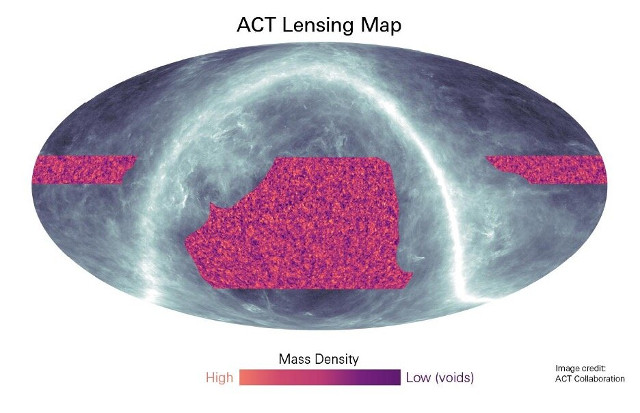
During the Future Science with CMB x LSS conference underway at Kyoto University, Japan, the results of a detailed mapping of dark matter in a part of the universe were presented. Three articles available in preview and submitted to “The Astrophysical Journal” illustrate these results, obtained using observations conducted at the Atacama Cosmology Telescope (ACT) in Chile, which operated between 2007 and 2022. This map (Image courtesy ACT Collaboration) was obtained by analyzing the cosmic microwave background radiation and its deviations caused to the gravity of massive structures such as concentrations of dark matter.
The continuous observations of gravitational effects generated by invisible masses led to the development of the idea of dark matter, a type of matter formed by particles different from those that form common, or baryonic, matter. The problem is that gravitational effects are the only way in which, at least for now, it’s possible to recognize the presence of dark matter and the reason why alternative models were developed that try to explain those effects in other ways. Currently, the Lambda-CDM model is the best at reproducing cosmological data and predicts that dark matter makes up over 80% of the matter existing in the universe.
Creating a map of something that is invisible may seem impossible and that’s certainly a complication. However, by exploiting the observable gravitational effects, it’s possible to map their sources, and therefore what, according to the models that are currently receiving confirmations, is the mysterious dark matter.
During its 15 years of operations, the Atacama Cosmology Telescope was used for various researches connected to the cosmic microwave background radiation, the emissions which permeate the cosmos and are considered a sort of echo of the Big Bang. Like all electromagnetic radiation, those microwaves are deviated by strong enough gravitational sources, just like concentrations of dark matter. Building on this principle, more than 160 researchers worked on data collected by the ACT to exploit those distortions in the obtained images in order to map the presence of dark matter in one part of the universe.
An interesting result concerns the “clumps” of dark matter detected in the data analyses. Attempts to map the dark matter using the starlight from more or less distant galaxies had indicated that it wasn’t “lumpy” enough compared to the predictions of the most accepted cosmological models. Instead, the map created using the cosmic microwave background offers results that more closely match the dark matter models with regard to their clumps.
Obtaining different results using different methods provides the chance to compare them, also to examine the data on which they are based and the methods used to analyze them to understand the reasons for the differences. That’s all the more important in research involving the cosmic frontiers that are farthest in space and time, where the precision of each measurement can be difficult to assess.
The articles submitted for peer review and subsequent publication may still be significantly modified. The Atacama Cosmology Telescope was decommissioned in 2022 but in such cases, the archives of observations keep on being used for many years. This means that we can expect more articles on the subject based on observations made with the ACT. New research will be conducted in the future at the Simons Observatory, also in Chile’s Atacama Desert, with a new telescope scheduled to enter service in 2024.

